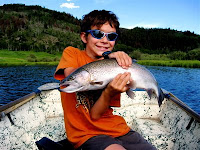 SEA BEANS (Salicornia sp.) are known by many names: beach asparagus, glasswort, pickleweed, samphire. They’re a succulent, salt-tolerant plant that grows along beaches, marshes, and mangroves around the world. In my region we find sea beans near the high tide mark along sandy or pebbly Puget Sound beaches.
SEA BEANS (Salicornia sp.) are known by many names: beach asparagus, glasswort, pickleweed, samphire. They’re a succulent, salt-tolerant plant that grows along beaches, marshes, and mangroves around the world. In my region we find sea beans near the high tide mark along sandy or pebbly Puget Sound beaches.
 Fresh, they make a crunchy seaside snack, and they retain that pleasing texture even after cooking. The flavor, is subtle, a salty taste of the sea with a hint of wild green. I like sauteed sea beans mostly for the texture, the bright color, and the salt, as in oyster succotash.
Fresh, they make a crunchy seaside snack, and they retain that pleasing texture even after cooking. The flavor, is subtle, a salty taste of the sea with a hint of wild green. I like sauteed sea beans mostly for the texture, the bright color, and the salt, as in oyster succotash.
Sea beans also make a colorful garnish. Pickling them means you can have sea beans whenever inspiration strikes.
Spicy Pickled Sea Beans
For the Southwest version I adapted a fairly standard pickling recipe for spicy green beans:
4 handfuls sea beans
4 red chiles
6 garlic cloves
pinch peppercorns per jar
pinch coriander seeds per jar
pinch mustard seeds per jar
4 sprigs fresh dill
1 1/4 cup water
1 1/4 cup white wine vinegar
1. Sterilize jars and lids in boiling water. 
2. When jars are cool enough to handle, add pinches of coriander, mustard, and peppercorns. Pack half full with sea beans. Insert chiles, garlic cloves, and dill around outside edges. Finish packing with sea beans.
3. Bring water and vinegar to a boil. Ladle over the sea beans leaving about 1/2-inch head space. Wipe jar edge clean and screw on sterilized lids.
4. Process in a boiling water bath for 10 minutes. Remove and allow to cool completely at room temperature. Check lids for proper seal. Store for at least one month before using to allow flavors to develop.
Yields 2 pints.
Asian Pickled Sea Beans
sea beans
rice vinegar
1 tbsp sugar per cup of vinegar
3 1-inch slices ginger per jar
1 star anise per jar
Figure on using at least 1 cup of vinegar for 2 half-pint jars. Oh, and rice vinegar and rice wine vinegar are essentially the same thing, in case you were wondering.
1. Sterilize jars and lids in boiling water.
2. When jars are cool enough to handle, pack with sea beans. Insert ginger slices around edges and a single star anise at top.
3. Bring rice vinegar and sugar to a boil. Ladle over the sea beans leaving about 1/2-inch head space. Wipe jar edge clean and screw on sterilized lids.
4. Process in a boiling water bath for 10 minutes. Remove and allow to cool completely at room temperature. Check lids for proper seal. Store for at least a few days before using to allow flavors to develop.
Word of warning: If you don’t own a dedicated canner with a rack (i.e. you use a big ‘ol pot instead, like me) be very careful with your jars to avoid breakage. I discovered this the hard way. Because the contents of the jars—the sea beans—are packed cold, your jars can experience a terrible fate called thermal shock and pop their bottoms off. Not pleasant. Keep the jars in the hot sterilization water until ready, pack them, don’t overscrew the lids (you know what I mean), then place carefully in the pot before bringing to a boil. In restaurant/software speak, this is called a “soft launch.”
 And don’t forget to use any leftover sea beans post-pickling. They make a salty garnish, or you can saute them in butter and garlic with a drizzle of lemon juice for a side dish. To leech out some of the salt, try blanching and shocking in two changes of water.
And don’t forget to use any leftover sea beans post-pickling. They make a salty garnish, or you can saute them in butter and garlic with a drizzle of lemon juice for a side dish. To leech out some of the salt, try blanching and shocking in two changes of water.
Like this:
Like Loading...




























 3
3

